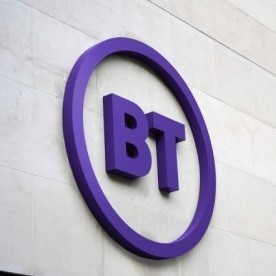The wasp drill and dropbot are among the robotics innovations that could help countries to slash their multi-billion-dollar spending on fiber rollout.

A small robot digs underground like a mechanical mole, tugging one of BT's fiber-optic cables to its destination point while technicians sip coffee and supervise. Around the corner, suspended like a cable car, another robot is replacing the final drop wire from the pole to the customer premises. The wasp drill and dropbot, as BT calls them, are potentially the future of broadband buildout, or rather a time- and expense-saving part of that buildout. Born of research at the operator's Adastral Park complex near Ipswich, they could also be a sales opportunity for BT in countries spending billions of dollars on fiber digs.
Before that happens, the team working on the robotics hopes these innovations and others will speed up fiber deployment and contain costs for Openreach, the networks bit of BT. Led by Jon Wakeling, a research director at Openreach, it comprises just five people plus an apprentice but draws on the expertise of specialist robotics companies and academia. The wasp drill appears to have come out of a partnership with Synthotech, a toolmaker that operates mainly in the market for water and gas pipework, and the University of Surrey, highly regarded as a research institute and for its telecom contributions.
That particular robot has extra-terrestrial origins, Wakeling told Light Reading during a recent interview at Adastral Park, with the design based on a drill the University of Surrey conceived for taking soil samples on Mars. As the name implies, it was inspired by the wood wasp and its egg-laying ovipositor, one of nature's most efficient digging mechanisms. (For appearance, imagine a traffic cone sawn lengthwise down the middle, with each half able to move on that axis.) "It is a new way of digging a hole," said Wakeling. "It hopefully removes the need to dig a trench, which is expensive and takes time."
Figure 1:  A BT engineer fiddling with a fiber-optic cable.
A BT engineer fiddling with a fiber-optic cable.
(Source: BT)
Whether it can be commercialized fast enough to make a big difference for Openreach is another matter. Under current plans, BT is investing about £15 billion ($18.3 billion) in the rollout of full-fiber networks to around 25 million homes by the end of 2026. It had passed almost 9 million homes at the end of September, according to its last set of results, giving it a long way to go. But the wasp drill remains a research project and might not become an everyday tool for many years.
Wakeling points out that customers will still need connecting long after that 2026 deadline for passing their premises. Here, the dropbot could prove especially relevant. Developed by Wakeling's own team, it should mean less use of ladders by engineers. "At the moment, the process involves laying out the fiber-optic cable on the ground and then winching it up," he said. "You attach this device to the existing copper cable, and you can control it using an app on a phone."
Sending robots overseas
The real excitement could lie in the export opportunity for BT and its UK partners. Wakeling's back-of-a-matchbox estimate is that the top 23 or 24 countries digging fiber networks today are collectively spending between £20 billion ($24.4 billion) and £25 billion ($30.5 billion) on civil engineering alone. "That is on putting up poles and digging," said Wakeling. "There is a massive opportunity to target that spend."
But whether inside or outside the UK, commercialization would be tricky, depending partly on the eventual cost of the robots. "If they are going to cost £5,000 [$6,100] each, we won't put them on the back of every single van but might call in a specialist service operator when we need it," said Wakeling. Closer collaboration with Synthotech or a robotics design boutique might improve the business case, he added.
Gadgets taken out of a lab and into the field would also have to be "ruggedized," an industry word for making them more resilient and less easy to damage. There are likely to be some health and safety concerns around operation, and technicians will also have to be trained up. Today, the wasp drill is more of a smart tool with a human operator than a fully functioning robot, Wakeling concedes. Ultimately, though, he wants to get to the point where it requires no intervention after it has been placed in a launch pit and programmed.
Want to know more about 5G? Check out our dedicated 5G content channel here on Light Reading.
Anything that can remove cost will look welcome to BT, whose capital expenditure has soared because of Openreach's fiber buildout. Excluding the cost of spectrum licenses, capital intensity – or capex as a percentage of revenues – hit 23% last year, up from just 14.4% in 2016, and is higher than the figure at any other European telecom incumbent. BT's operating margin has dropped from 17.7% to 15.2% over the same period.
The application of robotics to fiber construction certainly marks BT out. While clever drills have previously been developed for going deeper underground and crossing motorways, they cannot make 90-degree turns to accommodate drop-off points, according to Wakeling. "When you get to civil engineering for the streets around our homes, there has been very little innovation," he said.
Indeed, the way telecom companies deploy and maintain their infrastructure has changed little in the last 100 years, he reckons. "New tech has meant new shovels or drills that don't change the fact you need to dig a trench," he said. If ducts could be repaired without digging up entire streets, or cable installed at poles without closing roads, BT and its customers will not be the only ones celebrating.
Related posts:
— Iain Morris, International Editor, Light Reading
Read more about:
EuropeAbout the Author(s)
You May Also Like











